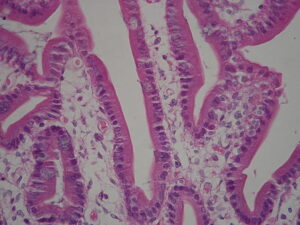The absorption of monosaccharides from the intestinal lumen to the inside of enterocytes is a process that does not occur by simple diffusion, that is following the concentration gradient, from a region of higher concentration to one of lower, but is mediate by specific protein transporters localized into the plasma membrane of enterocytes.
Absorption of glucose, galactose, and fructose
The passage of both the glucose and the galactose, chemically very similar, is mediated by a transporter called SGLT1, acronym of Sodium-dependent GLucose coTransporter 1, which carries out the co-transport of one molecule of glucose/galactose together with two sodium ions (then energy will be spent for removing sodium from the cell and so keeping the gradient along which other sodium may enter again).
Fructose, chemically different from glucose and galactose, enters into the cells by facilitated diffusion, also called passive transport (no energy expenditure) thank to the transporter GLUT5 (acronym of GLucose Transporter type 5).

All the three monosaccharides leave the cell through the transporter GLUT2 (acronym of GLucose Transporter type 2), enter into the bloodstream (portal vein), reach the liver and then are distributed to different tissues.
The absorption of electrolytes and solutes, in this case NaCl and monosaccharides, but the same is true e. g. for aminoacids, is accompanied by the movement of water, presumably by virtue of the osmotic gradient produced by absorption of the above-said molecules.
It is thought that SGLT1 is one of the major enhancer of water absorption and, based on experimental data obtained from studies on Xenopus oocytes, it seems that the transport of two sodium ions and one molecule of glucose is accompanied by the passage of 260 molecules of water, that is about 3 liter of water every 100 grams of glucose absorbed, and considering the transport of glucose taken up daily with foods, this might cause the absorption of several liters of water by the gastrointestinal tract (up to 9-11 liters if in the calculation aminoacids are taken in consideration as well).
References
- Belitz .H.-D., Grosch W., Schieberle P. “Food Chemistry” 4th ed. Springer, 2009
- Bender D.A. “Benders’ Dictionary of Nutrition and Food Technology”. 8th Edition. Woodhead Publishing. Oxford, 2006
- Hundal H.S., Darakhshan F., Kristiansen S., Blakemore S.J., Richter E.A. GLUT5 expression and fructose transport in human skeletal muscle. In: Richter E.A., Kiens B., Galbo H., Saltin B. (eds) Skeletal Muscle Metabolism in Exercise and Diabetes. Advances in Experimental Medicine and Biology, vol 441. Springer, Boston, MA. doi:10.1007/978-1-4899-1928-1_4
- Stipanuk M.H., Caudill M.A. Biochemical, physiological, and molecular aspects of human nutrition. 3rd Edition. Elsevier health sciences, 2012